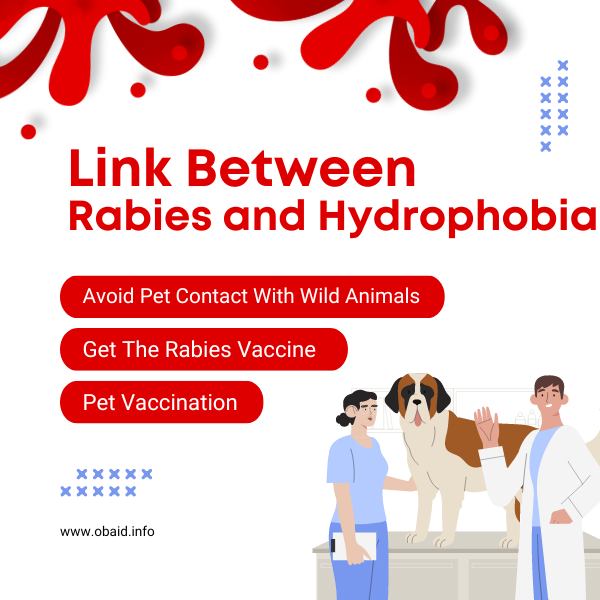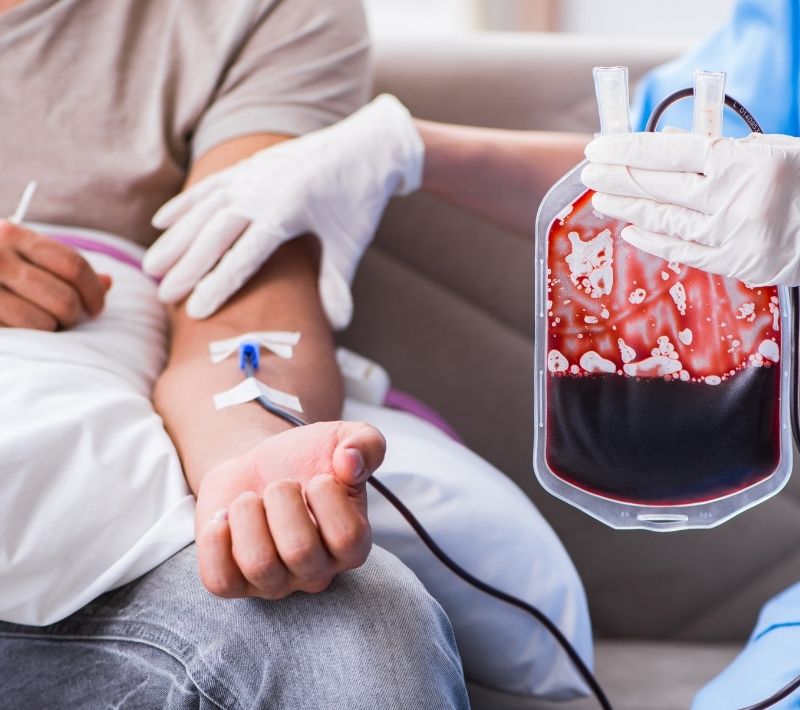Understanding the Link Between Rabies and Hydrophobia: The Fear of Water in Rabies Patients

Rabies, a viral disease affecting the central nervous system, is often associated with a symptom known as hydrophobia, characterized by a fear of water. This blog post aims to delve into the historical, clinical, and epidemiological aspects of the link between rabies and hydrophobia, shedding light on the significance of this association.
Historical and Clinical Perspectives
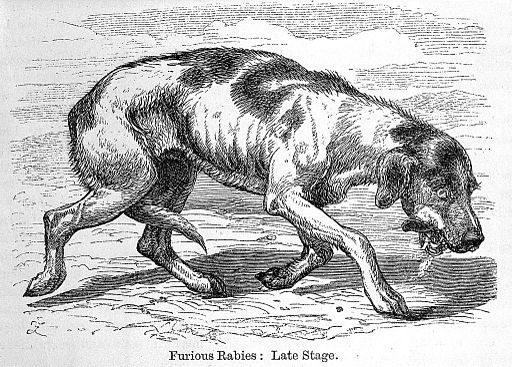
The term “hydrophobia” is derived from the Greek word meaning “dread of water.” It has been historically associated with rabies, reflecting the fear of water experienced by individuals infected with the rabies virus. The fear of water is a characteristic symptom of rabies and is often accompanied by other neurological manifestations such as agitation, confusion, and paralysis. The term “rabies,” meaning rage or madness, applies more especially to the disease as observed in the maniacal form in the lower animals [1]. PDF
Rabies Overview

Rabies is a deadly viral disease that affects mammals, including humans, and it’s crucial to get vaccinated against rabies to prevent the disease. The disease is primarily transmitted through the bite of a rabid animal, with the saliva carrying the rabies virus into the victim’s body, making it a crucial reason to get rabies vaccination for animals and humans alike. Once the virus enters the body, it travels to the central nervous system, leading to severe symptoms that can culminate in paralysis and death if left untreated.
Rabies remains a significant public health concern in many parts of the world, particularly in regions where the disease is endemic. The fear of water, a hallmark symptom of rabies, serves as a clinical indicator of the disease and underscores the urgency of seeking medical attention and post-exposure prophylaxis following potential exposure to the rabies virus.
Efforts to raise public awareness about the importance of vaccination, proper wound management, and timely medical intervention following animal bites are crucial in preventing the spread of rabies and mitigating the associated risks, including the development of hydrophobia and other neurological symptoms [2] .
Definition and Characteristics of Rabies
Rabies is characterized by a range of symptoms that progress rapidly once the virus enters the body. The most common characteristic of rabies is the development of hydrophobia, an irrational fear of water. This fear is often so intense that rabies patients may exhibit spasms and discomfort even at the thought of trying to drink water.
Transmission of Rabies
The transmission of rabies occurs through the saliva of infected animals, most commonly through bites, which is why it’s particularly important for a dog’s owner to ensure their pets are vaccinated against rabies. The rabies virus attacks the central nervous system, leading to symptoms such as fever, muscle spasms, and confusion. The fear of water, known as hydrophobia, is a classic symptom of rabies and can be a defining characteristic in diagnosing the disease.
Rabies is caused by the rabies virus, which belongs to the Lyssavirus genus. The virus is typically transmitted through the bite of an infected animal, usually a dog, bat, raccoon, or fox. When an rabid animal bites, the virus in its saliva enters the victim’s body through the wound. Animal bites are the most common mode of rabies transmission, accounting for up to 99% of human rabies cases worldwide.
In rare instances, rabies can also spread when the saliva of an infected animal comes into contact with a person’s mucous membranes (eyes, nose, mouth) or broken skin. Inhalation of aerosolized bat saliva in caves with large populations of bats is another very rare route. Human-to-human transmission of rabies is theoretically possible but extremely uncommon. There have been a handful of cases linked to organ transplants from infected donors, underscoring the critical importance of screening for rabies symptoms in such scenarios.
What are the first signs and symptoms of rabies?
The earliest symptoms of rabies are often vague and non-specific, making the infection difficult to identify at first, but recognizing these early rabies symptoms can be life-saving. Rabies patients may experience fever, headache, nausea, vomiting, agitation, anxiety, and confusion. Some people also have pain, prickling, or itching near the site of the bite as the virus activates the nerves in that area.
As the infection advances and inflames the brain and spinal cord, more severe neurological symptoms start to appear. These include:
- Cerebral dysfunction due to rabies: delirium, abnormal behavior, hallucinations
- Autonomic instability: hyperactivity, hypersalivation, sweating
- Hydrophobia: fear of water, painful throat spasms, difficulty swallowing
- Aerophobia: fear of drafts or of fresh air blowing on the face
- Paralysis: gradual weakening and loss of control of muscles
The “classic” signs like hydrophobia and throat spasms tend to manifest in the later stages of the disease. By the time a rabies patient shows a pronounced fear of water, the viral infection has already extensively damaged the nervous system. Without swift treatment, progressive paralysis, coma, and death are likely to follow within days.
Symptoms and Effects of Rabies in Humans
When a human is infected with rabies, the symptoms can vary depending on the type of rabies – furious or paralytic, making prompt diagnosis and a dose of rabies vaccines essential. Furious rabies presents with aggression, confusion, and hydrophobia, while paralytic rabies leads to weakness, paralysis, and difficulty swallowing due to rabies affecting the body’s ability to manage these functions. Understanding the diverse effects of rabies on the human body is crucial in preventing and treating this deadly disease.
Once the rabies virus enters the body, it travels along peripheral nerves to the spinal cord and brain. This process is not instantaneous – the virus’s journey to the central nervous system can take anywhere from days to months depending on the location of the initial bite and distance to the brain. On average, the incubation period for rabies is 2 to 3 months, but it may range from just a week to over a year in some cases. During this time, the rabies virus quietly spreads and multiplies with no noticeable symptoms.
When the virus finally reaches the brain and spinal cord, it triggers a destructive inflammation and disrupts critical functions. The infection spreads outwards, moving from the central nervous system to tissues and organs including the salivary glands. At this stage, rabies begins causing the severe symptoms like hydrophobia that make the disease so dreaded and notorious.
In rabies patients, hydrophobia typically manifests as a severe panic reaction at the prospect of drinking water. They may become agitated or combative if encouraged to drink. When they do try to swallow liquid, they are overcome by extremely painful throat spasms that feel like choking and suffocation.
The spasms can be so violent that they cause foaming at the mouth as saliva is forced out. Many patients spit and drool uncontrollably. Some become afraid to swallow their own saliva and spit frequently to avoid triggering the spasms.
Hydrophobia Connection
Understanding the link between rabies and hydrophobia is essential in grasping the intricate nature of this deadly disease and the irrational fear of water that often accompanies it, demonstrating how rabies cannot drink water can trigger severe reactions. The fear of water, known as hydrophobia, is a classic symptom of rabies, presenting a unique challenge in diagnosing and treating rabies patients.
The Link Between Rabies and Hydrophobia
Rabies and hydrophobia are intrinsically connected, with hydrophobia being a prominent symptom of the disease. Rabies is a viral infection that affects the central nervous system and can lead to symptoms such as fear of water, making it crucial to recognize the correlation between the two conditions for effective diagnosis and management.
How Rabies Causes Hydrophobia?
Rabies causes hydrophobia by affecting the brain and triggering an irrational fear of water in infected individuals. The rabies virus attacks the central nervous system, leading to neurological symptoms like hydrophobia, where the patient experiences extreme discomfort or even spasms at the thought of drinking water. Understanding the mechanism behind how rabies induces hydrophobia is crucial in addressing this unique aspect of the disease.
The answer lies in how rabies affects the brain and spinal cord. The rabies virus causes inflammation and dysfunction in key parts of the brain that control vital processes like swallowing. In particular, it disrupts the neural networks that coordinate the complex muscle movements needed to swallow liquids safely.
Normally, swallowing involves a precise sequence of muscle contractions in the mouth, throat (pharynx), and esophagus. These contractions guide food and liquid into the stomach while sealing off the airway to prevent choking, a function that can be severely hampered due to rabies leading to difficulty in swallowing. But when rabies inflames the brain, it makes the swallowing muscles go into spasms and fail to contract properly. Suddenly, that sip of water causes painful spasms and feels like it’s going down the wrong pipe.
Rabies patients quickly learn to associate water with choking and pain. Their brains react to water with a jolt of panic and dread. The sight, sound, or mere thought of drinking can trigger an overwhelming fear response. Even though they are thirsty, the idea of swallowing liquid becomes terrifying. This is the essence of rabies hydrophobia.
Fear of Water as a Symptom of Rabies
Fear of water, also known as hydrophobia, is a distinctive symptom of rabies and can manifest in various ways in infected individuals. This fear is a result of the virus’s impact on the brain and spinal cord, disrupting normal functions and triggering an aversion to water. Recognizing fear of water as a symptom of rabies is vital in differentiating the disease from other conditions and providing appropriate care to patients exhibiting this characteristic symptom.
How do throat spasms and paralysis make swallowing difficult?
Rabies damages the nervous system structures that control swallowing, leading to muscular spasms in the throat, larynx, and esophagus when swallowing is attempted. These spasms can be extremely intense and painful, like a severe Charlie horse in the throat.
The spasms disrupt the normal swallowing process and make it feel like water is going into the lungs. In a vicious cycle, the pain and fear of choking cause more tension and spasms, making the next attempt at swallowing even harder.
As the viral infection spreads, it begins to affect motor neurons, causing progressive muscle weakness and paralysis. The muscles involved in swallowing grow weaker and weaker. Mouth and throat muscles may fail entirely, making swallowing completely impossible.
The combination of spasms and paralysis creates a grim situation. The rabies patient Cannot drink water because their throat goes into painful spasms when they try to swallow. But they also cannot swallow because the muscles are becoming paralyzed. It is a truly nightmarish predicament.
Rabies Treatment and Prevention
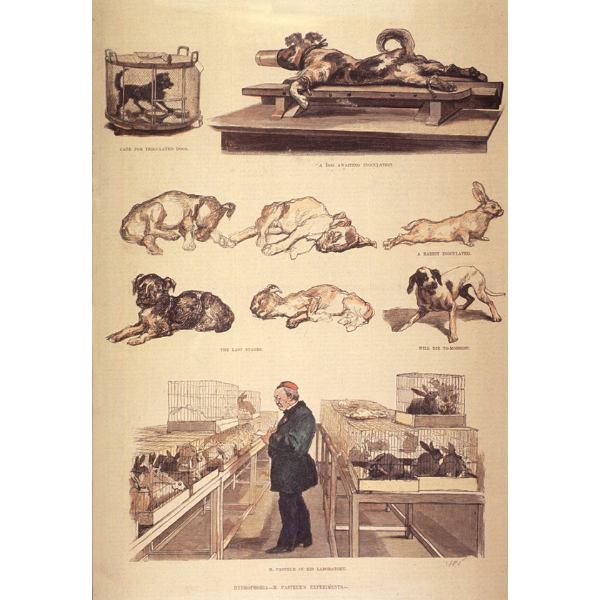
Effective treatment and prevention strategies are crucial in managing rabies, a viral disease that affects the central nervous system. Post-exposure prophylaxis is essential for individuals bitten by rabid animals, involving a series of rabies vaccinations to prevent the virus from causing infection. Prompt medical interventions, including administration of rabies vaccine and immunoglobulin, are vital in preventing the onset of rabies in exposed individuals, underlining the importance of understanding rabies symptoms for early detection.
Hydrophobia is a common symptom in rabies patients and can be challenging to manage. Patients may exhibit fear of water, making it essential to provide supportive care, such as sedation and hydration through IV fluids, to alleviate the distress caused by hydrophobia.
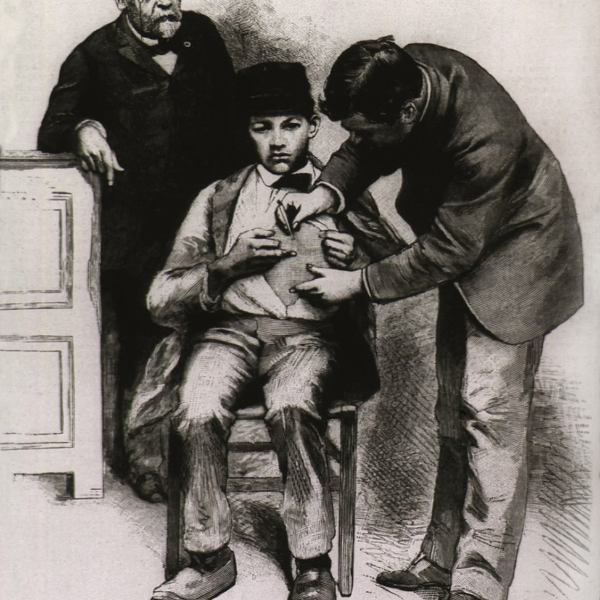
Impact of Rabies on the Central Nervous System
Rabies has a profound impact on the central nervous system, leading to neurological symptoms that can be life-threatening. The virus targets the brain and spinal cord, causing inflammation and dysfunction that manifest in symptoms like confusion, muscle spasms, and paralysis, all indicative of severe rabies symptoms. Understanding how rabies affects the central nervous system is crucial for effective diagnosis and management of the disease.
Rabies Virus and its Effect on the Brain and Spinal Cord
The rabies virus invades the central nervous system, infecting the brain and spinal cord and disrupting normal neural function. This disruption can lead to a range of symptoms, including hydrophobia, muscle spasms, and paralysis. The virus’s effect on the brain and spinal cord underscores the urgency of timely medical interventions to prevent severe complications of rabies.
Neurological Symptoms and Muscle Spasms in Rabies Patients
Rabies patients often experience neurological symptoms such as confusion, agitation, and hallucinations due to the virus’s impact on the central nervous system. Muscle spasms are a common manifestation of rabies, causing severe pain and discomfort in patients. Managing neurological symptoms and muscle spasms in rabies patients requires comprehensive medical care and supportive treatment to improve their quality of life.
FAQs

Q: Why can’t rabies patients drink water or Why Does Rabies Cause Fear of Water?
A: One of the peculiar characteristics of rabies is the development of hydrophobia, an irrational fear of water, in infected individuals. Rabies affects the central nervous system, triggering neurological symptoms like fear of water. This aversion can be so intense that rabies patients may experience spasms or extreme discomfort at the mere thought of drinking water.
Q: Is Hydrophobia Caused by Dog Bites?
A: Rabies, the viral disease that causes hydrophobia, is primarily transmitted through the bite of a rabid animal, with dogs being one of the main carriers. When an infected animal bites, the rabies virus in their saliva enters the victim’s body, targeting the central nervous system and leading to symptoms like fear of water.
Q: Is aversion to water a symptom of rabies?
A: Yes, aversion to water, also known as hydrophobia, is a classic symptom of rabies. The rabies virus affects the brain and spinal cord, disrupting normal neural functions and triggering an irrational fear of water in infected individuals. This symptom is crucial in diagnosing rabies and differentiating it from other conditions.
Q: Why does rabies cause dysphagia?
A: Rabies can cause dysphagia, or difficulty swallowing, as it affects the muscles and nerves involved in the swallowing process. The virus targets the central nervous system, leading to paralysis and dysfunction that can extend to the muscles responsible for swallowing. As a result, rabies patients may experience difficulty in swallowing food or liquids.
Q: What is the final stage of rabies?
A: The final stage of rabies typically involves severe neurological symptoms, including paralysis, confusion, and coma. As the virus progresses within the central nervous system, it can lead to respiratory failure and ultimately death if prompt medical intervention is not initiated. Recognizing the final stage of rabies is crucial for timely treatment and management.
Q: Why does rabies affect swallowing?
A: Rabies affects swallowing due to its impact on the central nervous system and the muscles involved in the swallowing process. The virus can cause paralysis and dysfunction of these muscles, leading to difficulty in swallowing food and liquids. Understanding how rabies disrupts normal swallowing function is essential in providing appropriate care to affected individuals.
Q: What does rabies do to your throat?
A: Rabies can affect the throat by causing inflammation and dysfunction in the muscles and nerves that control throat function. This disruption can lead to symptoms like difficulty swallowing, excessive drooling, and throat spasms. Recognizing the impact of rabies on the throat is crucial in managing symptoms and providing supportive care to patients.
Q: How does rabies spread to salivary glands?
A: Rabies can spread to the salivary glands through the nervous system, as the virus primarily targets the central nervous system upon entering the body, highlighting one of the key rabies symptoms. Once the rabies virus reaches the brain, it can travel through nerves to the salivary glands, leading to viral shedding in saliva. This transmission route underscores the importance of prompt treatment and prevention measures for rabies.
Q: Does Rabies Cause Hydrophobia in Dogs?
A: Yes, rabies can cause hydrophobia in dogs, leading to an irrational fear of water in infected animals. Dogs with rabies may exhibit symptoms like aggression, confusion, and fear of water as the virus affects their central nervous system. Recognizing and addressing hydrophobia in dogs with rabies is essential in preventing further transmission of the disease.
Q: What is the connection between rabies and hydrophobia?
A: Rabies is often associated with hydrophobia, which is the fear of water in rabies patients. This fear is due to the neurological symptoms caused by the rabies virus.
Q: Can rabies cause hydrophobia?
A: Contrary to popular belief, rabies itself doesn’t cause hydrophobia. The fear of water in rabies patients is a symptom of the virus affecting the brain and nerves.
Q: How does rabies transmission occur?
A: Rabies is transmitted through the saliva of an infected animal, usually through a bite. The virus enters the body and travels through the nerves to the brain.
Q: What are the symptoms of rabies?
A: Rabies symptoms appear after a period of time following exposure to the virus. Initial signs may include fever, headache, and weakness, progressing to more severe symptoms affecting the nervous system.
Q: Is rabies in humans almost always fatal?
A: Yes, if left untreated, rabies in humans is almost always fatal. This underscores the importance of seeking medical attention immediately after a potential exposure to the virus.
Q: How is rabies treated in humans?
A: Treatment for rabies in humans involves a series of rabies vaccines and immunoglobulin injections at the site of the bite. Post-exposure prophylaxis typically includes thorough wound cleaning and vaccination.
Q: What is the mortality rate of rabies in untreated cases?
A: The mortality rate of rabies in untreated cases is extremely high, with a fatality rate close to 100%. This highlights the urgency of obtaining medical care after a potential rabies exposure.
References
- Production of glycoprotein-deleted rabies viruses for monosynaptic tracing and high-level gene expression in neurons – Nature Protocols, Volume 5, Pages 595-606
- Estimating the Global Burden of Endemic Canine Rabies – PLoS Neglected Tropical Diseases, Volume 9
- Public Veterinary Medicine: Public Health: Rabies surveillance in the United States during 2018 – Journal of the American Veterinary Medical Association, Volume 256 2, Pages 195-208
- Rabies surveillance in the United States during 2019 – Journal of the American Veterinary Medical Association, Volume 258 11, Pages 1205-1220
- The spread and evolution of rabies virus: conquering new frontiers – Nature Reviews Microbiology, Volume 16, Pages 241-255
- Nontoxic, double-deletion-mutant rabies viral vectors for retrograde targeting of projection neurons – Nature Neuroscience, Volume 21, Pages 638-646
- Rabies virus-neutralising antibodies in healthy, unvaccinated individuals: What do they mean for rabies epidemiology? – PLoS Neglected Tropical Diseases, Volume 14
- Role of Oral Rabies Vaccines in the Elimination of Dog-Mediated Human Rabies Deaths – Emerging Infectious Diseases, Volume 26
- Novel role of SARM1 mediated axonal degeneration in the pathogenesis of rabies – PLoS Pathogens, Volume 16
- Trends and clinico-epidemiological features of human rabies cases in Bangladesh 2006–2018 – Scientific Reports, Volume 10
- Rabies Virus‐Inspired Silica‐Coated Gold Nanorods as a Photothermal Therapeutic Platform for Treating Brain Tumors – Advanced Materials, Volume 29
- Rabies – epidemiology, pathogenesis, public health concerns and advances in diagnosis and control: a comprehensive review – Veterinary Quarterly, Volume 37, Pages 212-251
- Vital Signs: Trends in Human Rabies Deaths and Exposures — United States, 1938–2018 – Morbidity and Mortality Weekly Report, Volume 68, Pages 524-528
- Portable Rabies Virus Sequencing in Canine Rabies Endemic Countries Using the Oxford Nanopore MinION – Viruses, Volume 12
- Monosynaptic Circuit Tracing with Glycoprotein-Deleted Rabies Viruses – The Journal of Neuroscience, Volume 35, Pages 8979-8985
- Non-neutralizing antibodies elicited by recombinant Lassa–Rabies vaccine are critical for protection against Lassa fever – Nature Communications, Volume 9
- Advances in RNA Vaccines for Preventive Indications: A Case Study of a Vaccine against Rabies – Vaccines, Volume 7
- Human rabies: 2016 updates and call for data – Releve epidemiologique hebdomadaire, Volume 92 7, Pages 77-86
- Oral vaccination of wildlife using a vaccinia–rabies-glycoprotein recombinant virus vaccine (RABORAL V-RG®): a global review – Veterinary Research, Volume 48
- Elimination of Dog-Mediated Human Rabies Deaths by 2030: Needs Assessment and Alternatives for Progress Based on Dog Vaccination – Frontiers in Veterinary Science, Volume 4
- Zero Endemic Cases of Wildlife Rabies (Classical Rabies Virus, RABV) in the European Union by 2020: An Achievable Goal – Tropical Medicine and Infectious Disease, Volume 4
- The Role of Dog Population Management in Rabies Elimination—A Review of Current Approaches and Future Opportunities – Frontiers in Veterinary Science, Volume 4
- Rabies surveillance in the United States during 2017 – Journal of the American Veterinary Medical Association, Volume 253 12, Pages 1555-1568
- Lyssaviruses and rabies: current conundrums, concerns, contradictions and controversies – F1000Research, Volume 6

